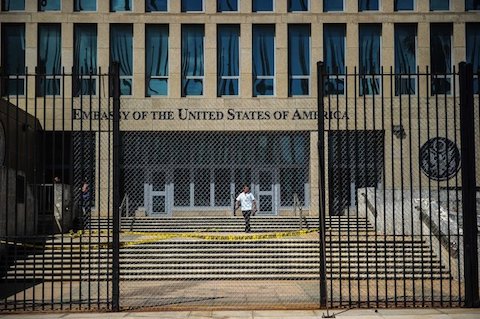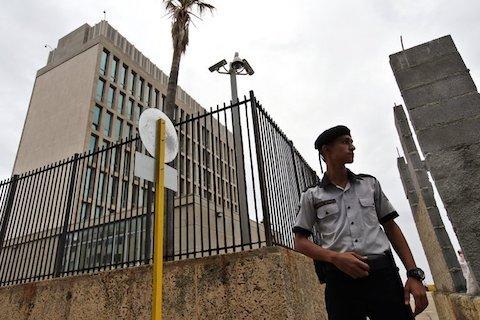A scientific enigma lies at the heart of a strange confrontation between the United States and Cuba.
According to the State Department, nearly two dozen diplomats at the American Embassy in Havana have been stricken with a variety of mysterious medical symptoms, including hearing loss and cognitive difficulties.
After concluding that staffers were the victims of a stealth attack, the department withdrew nonessential personnel from Havana and issued an advisory urging Americans not to visit. On Tuesday, the Trump administration expelled 15 Cuban diplomats from the United States.
The State Department has not provided further details about the medical condition of the affected staffers. But government officials have suggested anonymously that the diplomats may have been assaulted with some sort of sonic weapon.
Experts in acoustics, however, say that’s a theory more appropriate to a James Bond movie.
Sound can cause discomfort and even serious harm, and researchers have explored the idea of sonic weaponry for years. But scientists doubt a hidden ultrasound weapon can explain what happened in Cuba.
“I’d say it’s fairly implausible,” said Jurgen Altmann, a physicist at the Technische Universitat Dortmund in Germany and an expert on acoustics.
For decades, military researchers tried to transform sound into a nonlethal weapon that could stop enemy soldiers in their tracks.
“Why go in there with batons and guns when you can go in with something simple, like a sound generator?” said Dr. Geoffrey S. F. Ling, a neurologist at Johns Hopkins University and the former director of the Biological Technologies Office of the federal Defense Advanced Research Projects Agency.
The Pentagon funded development of loudspeakers to deliver long-range blasts of sound. The Navy uses them to ward off pirates, while the Army deploys them at checkpoints. In recent years, police have used so-called long range acoustic devices to break up crowds like those at the protests in Ferguson, Mo.
But these weapons work because they are insufferably loud, and if one were used against diplomats in Cuba, there would be no mystery about it. So speculation has swirled around another possibility: a device producing a sound outside the range of human hearing.
One possibility is infrasound — low-frequency sound that cannot be heard by humans. A report by the National Institute of Environmental Health Sciences in 2002 noted that the military had tried to weaponize infrasound but had not succeeded because it was hard to focus the wavelengths.
The primary effect of infrasound on humans “appears to be annoyance,” the report concluded.
Ultrasound is the more likely possibility. At frequencies higher than 20,000 hertz, beyond human hearing, ultrasound can damage tissue if produced with enough power.
Doctors use focused blasts of ultrasound to smash kidney stones. Decades ago, researchers created intensely powerful ultrasound beams in laboratories that can kill a mouse at close range.
Less powerful ultrasound beams don’t cause injuries and have a variety of medical uses, including commonplace medical scans. But there’s anecdotal evidence at certain intensities, they can make people very uncomfortable.
Steven L. Garrett, who taught acoustics at Penn State University before retiring last year, used to demonstrate ultrasound beams to his students. Often he would get nauseous and develop a headache; eventually he took to wearing protective gear.
“We didn’t use them any more unless we not only had earplugs in our ears, but earmuffs over the earplugs,” he said.

The American embassy in Havana on Tuesday. In response to an “attack,” the Trump Administration expelled Cuban diplomats from the U.S. Credit Yamil Lage/Agence France-Presse — Getty Images
Unfortunately, anecdotes like this make up most of what scientists know about the health effects of ultrasound. "The data is very slim," said Timothy Leighton, a professor of ultrasonics and underwater acoustics at Southampton University.
It's difficult to get people who report symptoms to volunteer for the studies, he said. And while the military, too, has investigated weapons based on sound beyond the audible spectrum, they dropped major research projects in the 1990's.
Even if another player has succeeded in developing an ultrasonic weapon, researchers said, the laws of physics make it unlikely that the device could harm diplomats from afar.
"Ultrasound cannot travel a long distance," said Jun Qin, an acoustic engineer at Southern Illinois University. The further the sound goes, the weaker it gets. And, noted Dr. Garrett, humidity in a place like Havana would weaken it still more.
Moreover, a beam of ultrasound will mostly bounce off the exterior of a building. What little sound got through would be of a lower, less harmful frequency.
One way to overcome these hurdles would be to use a bigger weapon. But a massive vehicle topped with a giant sound cannon in front of diplomatic houses would probably not go unnoticed.
"If you're talking about a ray-gun rifle knocking out someone with ultrasound they can't hear at a hundred meters -- that's not going to happen," said Dr. Leighton.
An ultrasound-emitting device planted inside a building, on the other hand, might be close and powerful enough to cause harm to occupants. But even an interior wall would block its waves.
A smaller emitter placed even more closely, perhaps in someone's pillow, might do the trick, said Dr. Qin. But it's hard to believe such a device could escape attention. In theory, a building could be packed with small emitters; however, experts called it unlikely.
And while ultrasound can cause many of the symptoms reported, there's no evidence that it can cause mild brain injury.
"I know of no acoustic effect that can cause concussion symptoms," Dr. Altmann said. "Sound going through the air cannot shake your head."
For all of these reasons, experts said, ultrasound weapons should not top the list of possible explanations for the hearing loss and headaches and other symptoms said to have been observed in diplomats.
"I believe those people got something that hurt them," said Dr. Qin. "But it could be something in the environment." The possibilities include toxins, or bacterial or viral infections, that can damage hearing.
Dr. Leighton said contagious anxiety or another psychogenic contributor couldn't be ruled out. "If you make people anxious that they're under attack from an ultrasonic weapon, those are the symptoms you'll get," he said.
Sorting through all those possibilities will be difficult now.
If a mysterious high-tech ultrasound weapon were used, it ought to have been easy to get the evidence while the attack was underway, Dr. Garrett said. Cellphone microphones are often sensitive to ultrasonic sound, he noted, and commonly available iPhone apps could have revealed it.
Investigators now are left to examine diplomats for telltale physical damage, like damaged eardrums.
"I think they missed their chance" to find the cause, he said. "It should be a piece of cake."


Spread the word